This stunning European trek features equally stunning food
By Keith Austin
The Camino de Santiago, aka Chemin de Saint-Jacques, aka the Way of St James, was one of the most important Christian pilgrimages during the late Middle Ages. No matter where pilgrims started from, all roads led to Galicia in north-western Spain and the cathedral of Santiago de Compostela, where it is said the remains of the apostle James are buried. One popular starting point was (and still is) the cathedral in the pretty provincial city of Le Puy-en-Velay in the Haute-Loire department of south-central France.
It seems appropriate, then, to start UTracks’ Food Lover’s French Way of St James 11-day tour inside the head of the Virgin Mary.
Made of cast-iron taken from more than 200 Russian cannons captured during the Crimean War, this hollow, 23-metre statue of Mary has dominated Le Puy-en-Velay from Corneille Rock – the town’s highest point – since 1860. For just €4 you, too, can climb the spiral stairs and, thanks to the transparent plastic bubble in the Virgin’s bonce, take in spectacular 360-degree views of the city.
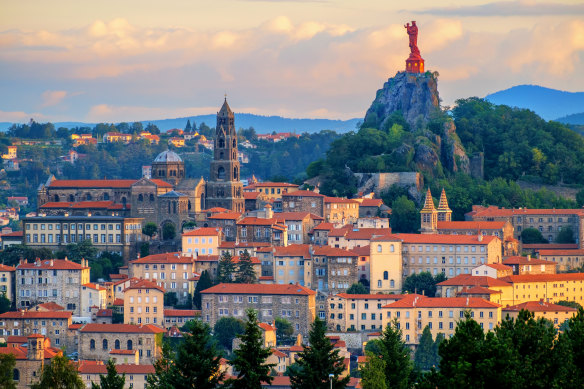
Le Puy-en-Velay and its statue of Mary on Corneille Rock.Credit: iStock
I am supposed to be meeting up with a Mary but not this one. Due to uncontrollable circumstances, I’m a little late to join the Mary Moody-led tour (it left two days ago) and will catch up with it in the village of Conques, 170 kilometres away to the south-west. Which is how, left to my own devices in Le Puy, I find myself up a ladder in la tête de la Vierge Marie.
Le Puy isn’t just the jumping-off point for the Food Lover’s tour, of course. It has a charming old city centre and an impressive cathedral, which clings to the side of Corneille Rock and comprises a rambling cluster of buildings built mostly between the fifth and 15th centuries. The city is also known for both its eponymous lentils and Verveine du Velay, a local botanical liqueur made of 32 plants, herbs and spices that tastes like a herbal bath bomb mixed with rocket fuel. Stick with the lentils.
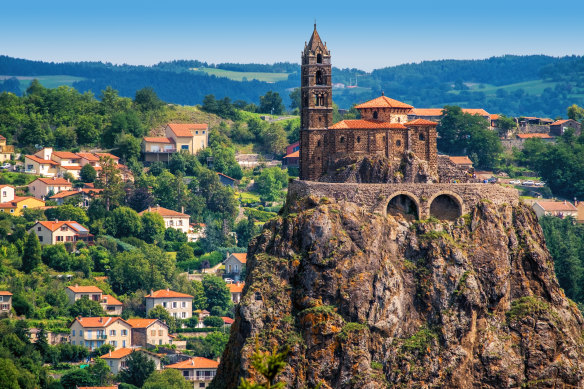
Le Puy has a charming old city centre and an impressive cathedral.Credit: iStock
Medieval Conques, where I head the next day, is a charmingly cobblestoned village with a permanent population of just 89 – vastly different to the 3000 or more who lived there in the 11th century, when the abbey church of St Foy came into possession of the bones of a young Christian martyr by way of “furtive relocation” – known to us today as stealing. The Treasury of St Foy, tucked away in the cloisters next to the church, is fascinatingly and unexpectedly full of priceless reliquaries, including a gold and gem-encrusted statue said to contain part of the saint’s skull.
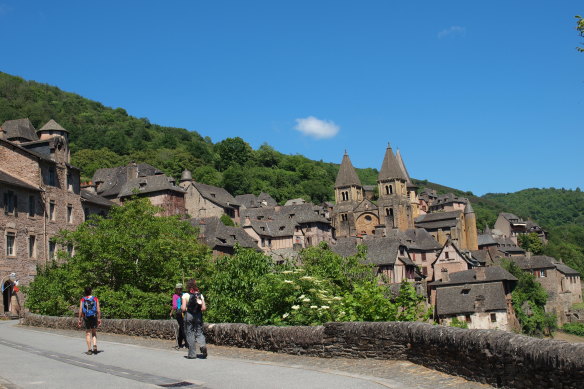
On the trail into Conques.
It’s here that I finally catch up with the group and its leader, the irrepressible Mary Moody. In the coming days there will be hiking along sections of the Camino through wheat fields, forests and vineyards fecund with fruit; there will be beautiful villages and towns stuffed like sausages with history and religion; there will be dinners and lunches to bring tears to the eyes of even the greediest gourmand; and there will be much continuing mirth at the idea of “furtive relocation”. But, let’s be honest, the icing on the cake is Mary Moody.
For while this group of Australians and two stray New Zealanders very much appreciates the beauty of this region of France and its fine fare (at least from the enthusiasm with which they strap on the nosebags each day), a big part of the attraction is to do all this in the company of a woman who, thanks to her work as a journalist, author and long-time presenter on Gardening Australia, is a much-loved household name.

Journalist, author and long-time presenter on Gardening Australia, Mary Moody.
And she doesn’t disappoint. “This must be the only walking holiday where you put weight on. Maybe we should call this Mary’s Lurch through the Lot,” she says at one point, referencing the region we’re travelling through. And later: “I like to think of this tour as a roller-coaster ride of experiences. So tomorrow we’re going to McDonald’s.” Naturally, we’re doing nothing of the sort but it’s very Mary Moody – impish, earthy, mischievous and endlessly amusing.
The tour follows the Way of St James pilgrimage route south-west and finishes in St Jean Pied de Port, just eight kilometres from the Spanish border, where the final stage of the Camino across Spain starts. Along the way, it takes in the almost comically beautiful villages of Saint-Come-d’Olt, Conques, Rocamadour and Saint-Cirq-Lapopie.
It is a journey during which we slowly stuff ourselves – not unlike France’s controversial force-fed geese – with lentils, cheese, duck, wine, liqueurs, aligot (a type of cheesy mash potato with the consistency of glue) and anything else that comes to hand. Meals range from rustic regional bistro fare to DIY market-bought picnic baguettes, a simple dinner with nuns in a convent, and an extravagant epicurean feast in a Michelin-starred chateau.
There are visits to the Laguiole knife museum, a truffle-dog hunting demonstration (and tasting), guided abbey tours and a visit to an Armagnac distillery.
You know how there are some places so stunning that you just want to turn to the person next to you – stranger or not – and say, “are you seeing this, too?” Well, one such place is Rocamadour. Before driving in (our beautiful boutique hotel is slap-bang in the middle of the village) we stop on the outskirts at a viewing area. From here, we look across a wooded valley at a seemingly haphazard cluster of grey stone buildings clinging to a sheer cliff-face which is, in turn, topped with an ancient abbey. It’s so much part of the local geology that it looks as if it grew there. Or perhaps a landslide that just happened to settle, surreally, in the shape of a village.
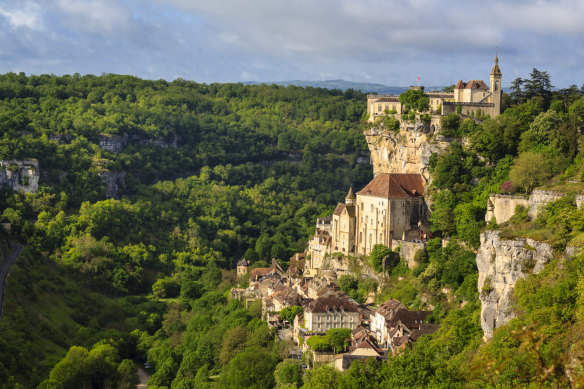
Rocamadour – one of the most beautiful and most visited medieval villages in France.Credit: iStock
It’s then that Julie, who hails from Melbourne, takes the words out of my mouth and says: “It just gets better and better. Every day I think, wow, this is the most beautiful French village I’ve ever seen, and then …”
And then along comes Saint-Cirq-Lapopie, which we reach via a 10km hike along the Lot River, then a climb to where the village squats like a stone crown on a rocky headland. Voted France’s favourite village in 2012, St-Cirq-Lapopie is a thing of true beauty, a surreal film-set of a place that almost defies description. Its meandering narrow, maze-like streets and shady squares are lined with restaurants, bars, cafes and shops housed in buildings dating from the Renaissance and the Middle Ages. It’s one of those places where you start looking in the real-estate agents’ windows and wondering if maybe, perhaps…
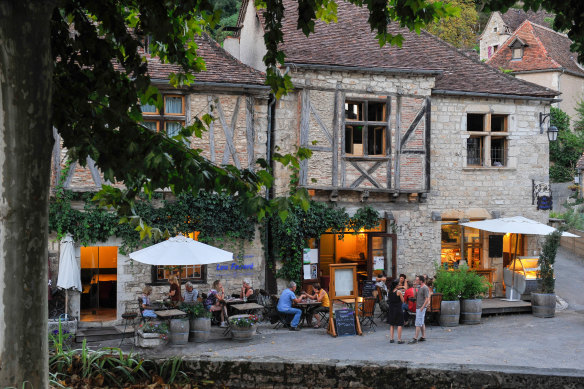
A cafe in Saint-Cirq-Lapopie.
And guiding us safely through all this with quick wit, good sense, a generous heart and an endless supply of anecdotes from a life well-lived is Moody. A journalist on the Australian Women’s Weekly in the 1960s and a presenter on ABC’s Gardening Australia from 1991 to 2001, Moody has written more than 40 gardening books and five memoirs – Au Revoir, Last Tango in Toulouse, The Long Hot Summer, Sweet Surrender and The Accidental Tour Guide. In 2007 she produced a documentary for SBS based on Lunch with Madame Murat, her 2005 book about the 100-year history of a traditional family restaurant – Chez Jeanne – not far from Moody’s long-term second home in south-western France.
And it’s lunch at Madame Murat’s that stands out on a tour studded with highlights.
When we pull into the car park, fresh from a mooch around Moody’s house in the nearby village of Frayssinet-le-Gelat, lunch is already in full flow and the place is busy and buzzy. This is a restaurant without pretensions, where local workmen rock up for a solid feed alongside tourists anxious to experience Murat’s simple but hearty fare. The blackboard menu lists omelette aux cepes, foie gras, and confit de canard, while our set lunch of vegetable soup, country pate, a main of braised lamb with ratatouille and fries is finished off with home-made apple tart and ice-cream.
As plates of vegetable soup and bottomless bottles of home-made Malbec – the local “black wine” that has been synonymous with the Cahors region since the Middle Ages – arrive our long table, Moody explains that it is traditional here to “faire le chabrol”. At first, I suspect this is another example of Moody’s wicked sense of humour – after all, faire le chabrol translates as “drink like a goat” – but it turns out to be a longstanding rural custom of pouring a little red wine into the dregs of your soup and drinking it straight from the bowl. It takes some getting used to, but soon we’re all slurping away as though born to it – though it might be some time before it makes its way to the dinner tables of Australia. Go on, give it a go. Drink like a goat. Mary Moody said it’s OK and that’s good enough for me.
THE DETAILS
Fly + train
Several major airlines fly from Australia to Lyon St-Exupery, the closest airport to Le Puy-en-Velay, via Dubai or Paris Charles de Gaulle. The Rhonexpress tram (€16.30/$27 one-way) runs regularly from the airport to Lyon Part-Dieu train station. Ticket machines are just past the baggage hall or you can book online. See rhonexpress.fr
From Lyon Part-Dieu, trains go to Le Puy-en-Velay via a change at St Etienne and take about three hours. Keep an eagle eye on the departure boards at St Etienne. See sncf.com/en
Tour
Two tours (May and September) will likely be available in 2025. Prices start from $7990 a person, twin share. The package includes accommodation and most meals, including one at a Michelin-starred restaurant. There are six guided visits and two wine tasting sessions.
Most days include walks of 10km-15km along the best parts of the St James Way and is rated grade 2 (introductory to moderate), mostly over easy terrain, and considered suitable for active people who have a reasonable level of fitness. A support vehicle carries baggage from hotel to hotel and remains close by in case conditions change. See utracks.com
Tours will be led by others from Utracks while Mary Moody deals with some health issues. Tours will still include visits to Mary Moody’s village, house and Mme Murat’s restaurant.
The writer was a guest of UTracks.
Sign up for the Traveller Deals newsletter
Get exclusive travel deals delivered straight to your inbox. Sign up now.